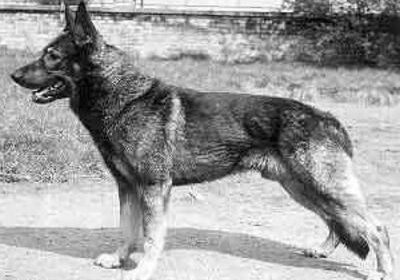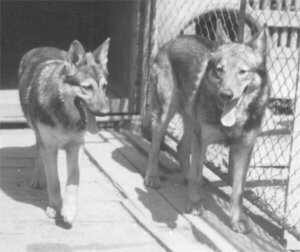History of Czechoslovakian Vlcak
The history of the breed has been edited and reposted with permission from Margo Peron, z Peronówki kennel, Poland. Additional history provided by Lukas Michalicka, Sonata Carpathica kennel, Slovakia.
In the year 1955, a biological experiment took place in the former Czechoslovak Socialist Republic (CSSR) of that time, namely, the crossing of a German Shepherd Dog with a Carpathian wolf. The military experiment established that the progeny of the mating of male dog to female wolf as well as that of male wolf to female dog, could be viable and reared. The overwhelming majority of the products of these matings possessed the genetic requirements for continuation of breeding. In the year 1965, after the conclusion of this experimental stage, a new plan, originally designed for inclusion in the German Shepherd Dog studbook, was worked out. This was to combine the usable qualities of the wolf, such as pack-behavior, endurance and health, with the favorable qualities of the dog. Over time, however, the progeny of this experiment remained separated from the studbooks for German Shepherd Dogs and eventually in the year 1982, the Czechoslovakian Vlcak, through the general committee of the breeder's associations of the CSSR of that time, was recognized as its own national breed.


Where is the origin of this breed and who is the author of the idea of crossbreeding German Shepherds and wolves? It is necessary to go back as far as 1955 when Ing. Karel Hartl began to work with the idea at the kennels of the Border Guard in Libejovice. The first attempts to mate the she-wolf Brita with the chosen German Shepherd were unsuccessful as he was roundly rejected by Brita and severely injured. Another stud dog was selected and the first hybrids of the above-mentioned she-wolf and the German Shepherd Cézar z Březového háje were born on May 26, 1958 (1st line of CsV).


Anatomical and physiological differences between the hybrids and both parental forms were examined in a detailed way; their capacity for training, activity and tenacity was tested. Through strict culling, chosen hybrids were mated again with non-related German Shepherd Dogs. Puppies from the second filial generation could be trained if they were taken from the kennels and hand-reared individually. Hybrids of the generations F3 and F4 were commonly used as service dogs in the army.
In 1960, the she-wolf Brita was also mated with the German Shepherd Dog Kurt z Václavky (2nd line of CsV) and thus she whelped the first two lines of the hybrid. A third line was also born in Central Bohemia, modern day Czech Republic; its founder was the male wolf Argo. The female German Shepherd Asta z SNB gave birth to his offspring in the Police kennels in Bychory in 1968 (3rd line of CsV). The abbreviation "CV" (Czech Vlcak) started to be used for the interline hybrids. In the 1970s, the majority of the hybrids were sent to new Slovak kennels near Malacky, which belonged to the Bratislava section of the Border Guard. For the next ten years, there would only be litters whelped in Slovakia.
The best of the breeding dogs were able to get far from the Iron Curtain and so Slovakian breeders who took up the project could work on unifying the external and temperament traits of the new breed-in-foundation. The Vice-commander of the above-mentioned kennels, Major Frantisek Rosik, until his passing in 2015 the lifetime honorary president of the Slovak Club of Breeders of the Czechoslovak Vlcak in Bratislava, undoubtedly took the greatest credit for the development of the breed in its current recognized form.
In 1972, a third male wolf Sarik enriched the population in Malacky, Slovakia (4th line of CsV). He was mated with a female hybrid of the F3 generation Xela z Pohraniční stráže and with a female Czechoslovakian Vlcak Urta z Pohraniční stráže. The name "Czech Vlcak" (CV) was gradually changed to "Czechoslovakian Vlcak" (CsV), under which the breed was later recognized.
The last wolfblood entry into the fond of genes of the breed was the mating of the she-wolf Lejdy with the German Shepherd Bojar vom Schotterhof, which again took place in the Southern Bohemian town of Libejovice and the puppies were born on April 26, 1983 (5th line of CsV). Kazan z Pohraniční stráže (F1), born from this mating, was used directly in breeding CsV. These five established paternal lines and the additional ~40 purebred military working-line German Shepherd Dogs subsequently and selectively used on the F1 - F4 progeny are the official recognized foundation of the Czechoslovakian Vlcak breed.
From 1971 through 1981, the breed was developed exclusively in Slovakia between both the Malacky border patrol kennels as well as civilian breeders, and under the supervision of Frantisek Rosik, proliferated beyond early generation mixes into a developed breed.
From the beginning when Czechoslovakian Vlcak were moved into the hands of civilian breeders, kennel organizations in Czechoslovakia refused all attempts of Ing. Karel Hartl to gain recognition for the Club of Breeders of CsV and to record breedings into the pedigree register. It was not until a meeting of the Club held on March 20, 1982, in Brno, Czech Republic, that the first 43 puppies were entered in the Main Pedigree Register in Prague and recognized as a national breed in the Slovak Kennel Club (SKJ), under the chairmanship of Frantisek Rosik, the first chairman of the breed club. In the span of ten years (1982 - 1991), 1552 puppies were recorded. In 1989, the breed was provisionally recognized by the Fédération Cynologique Internationale (FCI) - the World Canine Organisation and all ninety-one participant countries' national kennel clubs, with full recognition granted on June 1, 1999 after all requirements on the sustainability of the breed and standardization were met. Since 2001, the breed has been recorded in the AKC Foundation Stock Service and in 2006, fully recognized by the United Kennel Club. From January 1, 2010 Czechoslovakian Vlcak became eligible to compete in AKC Companion Events - Obedience, Rally, Tracking, and Agility.
